Disinfection and post-virus cleaning
Employee sick leave can cost up to 6% of your annual salary.
See how a well-planned disinfection strategy has transformed the performance of businesses in Harjumaa.
- How to distinguish between normal cleaning and professional disinfection to ensure effective protection against viruses?
- What specific methods and tools do professionals use for effective antiviral disinfection and why do they work better than conventional cleaning products?
- What is the optimum disinfection schedule for different offices and how can it be adapted to seasonality and outbreaks?
Disinfection as a business decision, not a cost item
“I saw half of our office fall ill in one week,” recalls Taavi, an IT manager from Tallinn. “At first it just seemed like an unpleasant coincidence. But when I started to add up all the lost working days, extra hours to replace them and postponements of client meetings, the real cost was shocking.”
Taavi is not alone. Statistics from businesses in Harju County show that employee sick days account for an average of 4-6% of the annual wage bill – and this figure does not include indirect costs such as overtime, project delays and loss of potential new customers. Managers of the most successful companies are discovering that investing in professional disinfection and post-virus cleaning services is not an expense, but a worthwhile investment that quickly pays for itself.
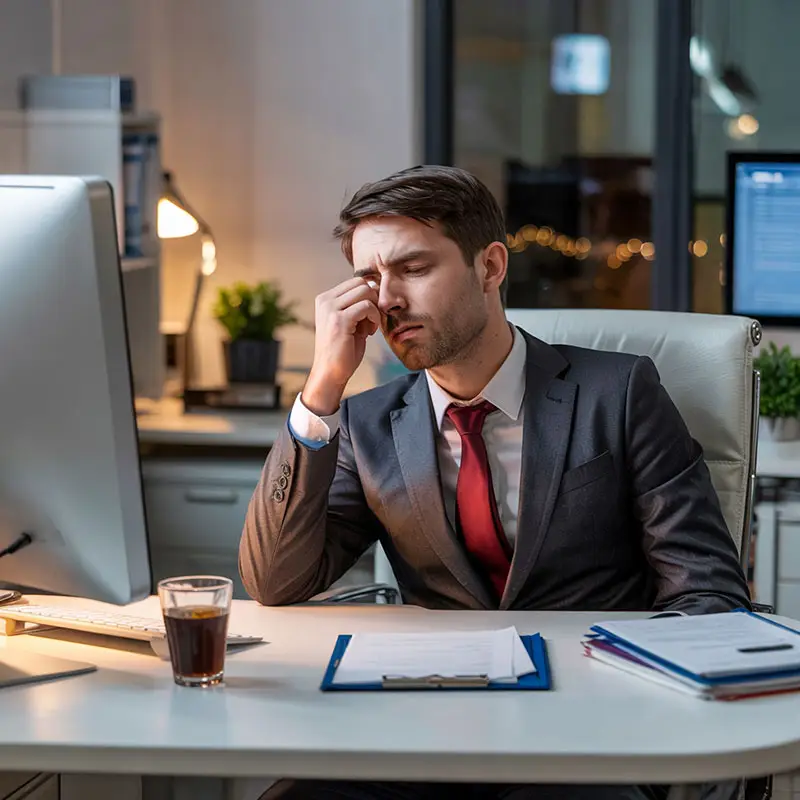
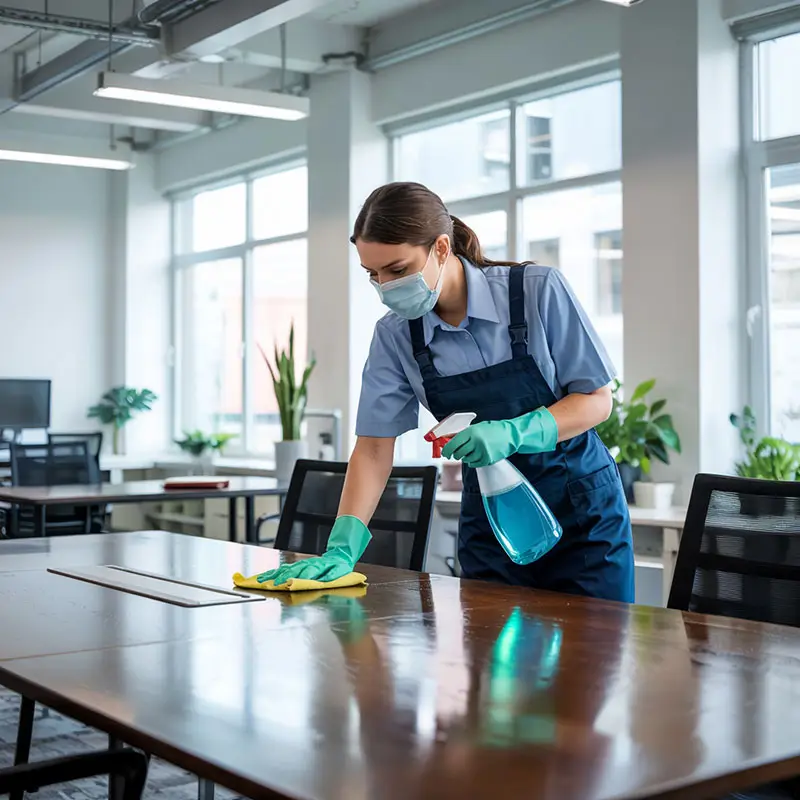
Why doesn't normal cleaning protect your staff from viruses?
Important differences between disinfection and normal cleaning operations
Conventional cleaning services focus on removing visible dirt and ensuring general cleanliness. But to effectively remove microbes, bacteria and viruses, a special approach is needed. Disinfection and post-virus cleaning uses scientifically proven methods that destroy pathogens, rather than simply dispersing them on surfaces.
“When people think of cleaning, they think of dusting and scrubbing the floor,” explains Kristjan Tamm, disinfection services expert at SPS Group. “But most common cleaning products have no effect against viruses. In fact, the wrong technique can even encourage the spread of infection.”
Hidden sources of danger in your office
Studies show that the average office keyboard contains 7,500 bacteria per square centimetre – more than a public toilet seat. Other high-risk areas include:
- Telephones (up to 25,000 microbes per square centimetre)
- Useless (2000-3000 bacteria per square centimetre)
- Coffee maker buttons (up to 5000 microbes)
- Meeting room chairs and tables (1500 microbob per square centimetre)
These points of contact can become ‘hubs’ for viruses, spreading diseases from worker to worker. And some viruses are able to live on surfaces for up to 72 hours, allowing the next person to be infected long after the initial contact.
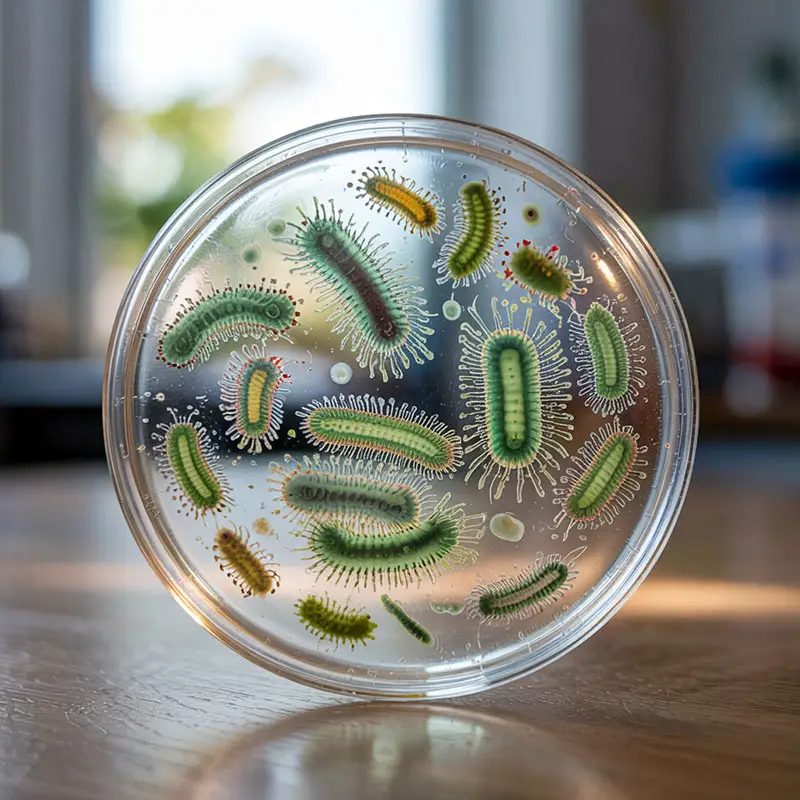
Efficiency of professional disinfection
Professional disinfection and post-virus cleaning differs from normal cleaning in several important ways:
Special tools
Antiviral disinfectants with proven efficacy against different pathogens are used.
Systematic approach
A specific procedure is followed to avoid cross-contamination of contaminated sites. Cleaners are trained to deal with infectious environments.
Contact
Professionals ensure that disinfectants remain on surfaces for a sufficient time (usually 5-10 minutes) to achieve maximum effectiveness.
Special equipment
Electrostatic sprays, UV technology and other advanced tools are used to effectively destroy viruses.
“At first, I was afraid that regular disinfection would be too costly for our company,” admits Veiko, owner ofa 20-employee accounting firm in Tallinn. “But after the first year, when I compared the number of sick days with the previous period, the difference was noticeable. We saved nearly €15,000 in direct costs.”
The importance of choosing the right tools
Not all disinfectants are created equal. Professionals choose tools that:
“One of the main mistakes we see is the use of inappropriate tools on different surfaces,” says Tamm.. “For example, alcohol-based disinfectants can damage leather furniture, while ammonium-based products can leave streaks on screens.”
Have a broad spectrum of activity against different pathogens
Has been tested and proven effective against COVID-19 and other respiratory viruses.
Suitable for specific surfaces (wood, metal, textile, electronics)
Leave minimal residue and odour
The main components of professional disinfection
Modern methods and technologies to effectively remove viruses
Today’s disinfection technologies have evolved far beyond simple surface wiping. The most effective methods for post-virus cleaning include:
- Electrostatic spraying devices: these devices electrically charge the disinfectant particles, causing them to “cling” to surfaces, ensuring uniform coverage even in hard-to-reach areas.
- UV-C disinfection: UVC radiation destroys the DNA structure of viruses and bacteria, rendering them harmless without the use of chemicals.
- Dry steam cleaning: high-temperature steam (over 170°C) can destroy most viruses and bacteria without damaging surfaces.
- Fog and aerosol systems: these systems fill the room with a fine mist of disinfectant that reaches all surfaces, including ceilings and behind equipment.
“Electrostatic spraying is a revolutionary method,” explains Kristel Rebane, disinfection specialist at SPS Group.“It ensures that the disinfection and post-virus cleaner covers surfaces with 360-degree coverage, reaching areas that conventional cleaning simply cannot reach.”
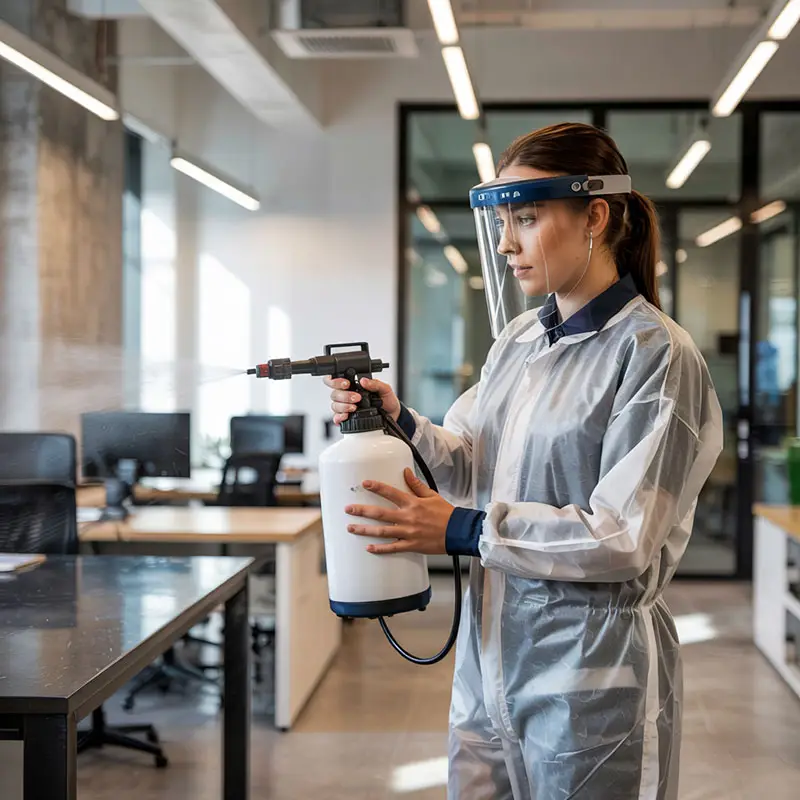
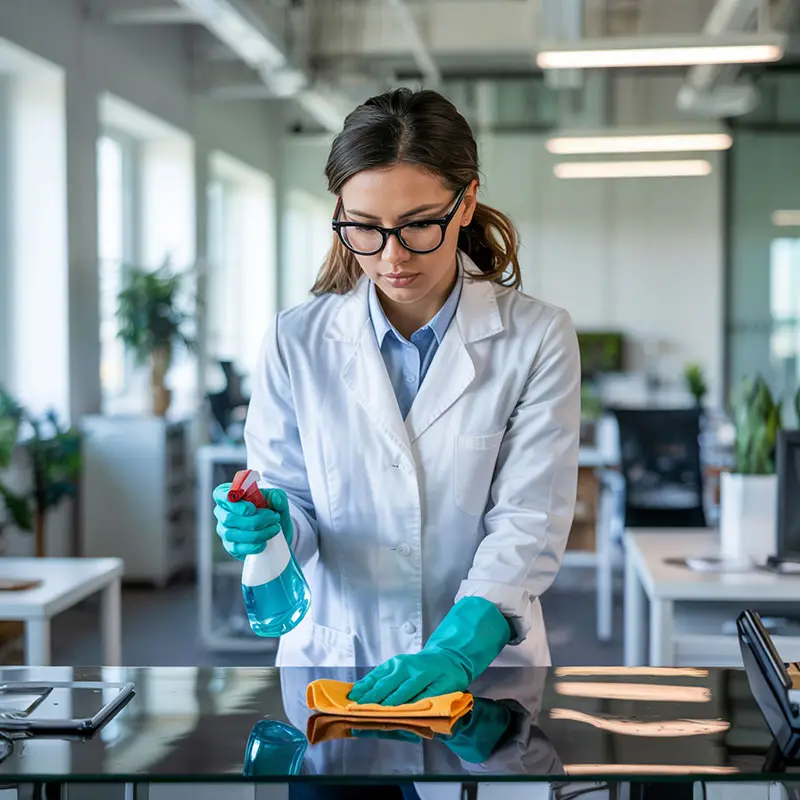
Disinfection process steps in the office
Professional disinfection and post-virus cleaning follows a structured approach:
- Assessment: analysis of premises, mapping of high-risk areas and materials.
- Preparation:Cleaning surfaces from dirt and organic material.
- Disinfection: applying the right disinfectant according to the type of surface and the risk level.
- Contact time: ensuring that the product remains on the surface for the time recommended by the manufacturer.
- Final cleaning: removal of disinfectant residues, if necessary.
- Quality control: checking the results (often by means of an ATP test).
- Documentation: accurate recording of areas treated and methods used.
Marit Laane’s marketing agency in the centre of Tallinn is a prime example of how a strategic approach to disinfection and post-virus cleaning can drastically change the health environment of a business.
“In the past, it was common for at least a third of our 15-strong team to fall ill during a flu or norovirus season,” recalls Marit. “2023. At the beginning of 2009, we lost a total of 42 working days in one month due to sickness. That was the moment we decided we needed a professional solution. “
A strategic approach to disinfection
Optimal frequency according to season and risk level
“One of the main mistakes we see is the use of inappropriate tools on different surfaces,” says Tamm.. “For example, alcohol-based disinfectants can damage leather furniture, while ammonium-based products can leave streaks on screens.”
October-March
High risk
Complete disinfection every 2-4 weeks
April-May
Medium risk
Complete disinfection once a month
June-September
Low risk
Complete disinfection every 6-8 weeks
Whole year
Low risk
Daily disinfection of touch points (door handles, switches, keyboards).
In addition, the disinfectant and the frequency of post-virus cleaning should be adapted to the specifics of your business:
- High footfall businesses (customer service): tighter schedule
- Offices with less traffic (project-based work): less frequent schedule.
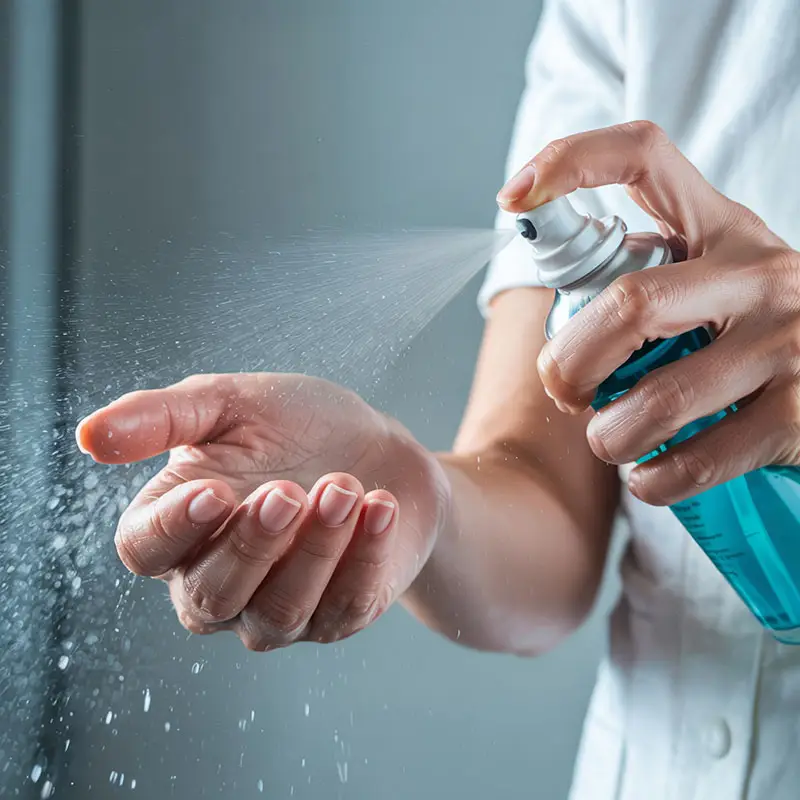
Employee engagement and training
Even the best professional disinfection and post-virus cleaning is more effective if workers follow good hygiene practices on a daily basis. A recommended strategy includes:
- Ensuring the availability of hand sanitisers throughout the office
- Training staff to disinfect personal workplaces
- Establishing clear protocols to prevent people coming to work with signs of illness
- Regular reminders and awareness-raising during the season of viral diseases
Ask for a special offer for your business
Protect your team and your business with professional disinfection.
Don’t let sick days undermine the performance of your business. As Marit and many other businesses in the Harju County have discovered, a properly planned disinfection strategy and post-virus cleaning can mean significant savings in both money and time.
Contact us for a free consultation where we will assess the risk areas of your office and draw up a disinfection plan tailored to your needs. Our experts will develop a solution that’s right for your business size, sector and budget.
“An investment in cleanliness is an investment in productivity. Our disinfection programme has reduced sick days by 68% in the first six months of the year. .” – Marit L., Marketing Agency Manager from Tallinn, Estonia
Frequently Asked Questions (FAQ)
How often should office premises be professionally disinfected?
The optimal frequency depends on a number of factors, including the size of your office, the number of employees and the season. In general, full disinfection at least once a month is recommended during the peak virus season (October to March), in addition to daily cleaning of touch points. In low-risk periods, quarterly thorough disinfection may be sufficient.
Will disinfection damage office furniture or electronic equipment?
A professional disinfection service provider will use different tools depending on the type of surface. Modern disinfectants are usually safe for most surfaces, but special methods are used for more sensitive equipment. Before ordering a service, it is worth mentioning any sensitive materials or equipment to ensure their preservation.
How long should I wait after disinfection before staff can return to the premises?
It depends on the method used. UV disinfection allows immediate access after treatment, while chemical fogging processes may require 2-6 hours curing time. We usually schedule disinfection for evenings or weekends to minimise disruption.
Are eco-friendly disinfectants as effective as traditional chemicals?
Many modern ecological disinfectants have proven their effectiveness against viruses. However, some may require a longer contact time with the surfaces for optimal results. A professional service provider can recommend the best ecological solutions that do not compromise efficiency.
Is it enough to simply spray disinfectant on surfaces?
No, effective disinfection is a multi-step process. First, the surfaces must be cleaned of dirt and organic material, then the disinfectant must be applied in the correct concentration and allowed to act for the prescribed time (usually 5-10 minutes). Spraying the product too lightly or sweeping too quickly will not give the desired result.
How do I know if the disinfection was effective?
Professional service providers can carry out ATP (adenosine triphosphate) tests before and after disinfection to measure the level of organic material (including bacteria) on surfaces. It is also possible to use UV indicators to show whether all surfaces have been treated. The most noticeable result, however, is a reduction in sick days in your company.
What is post-viral cleaning and when is it needed?
Post-viral cleaning is a special disinfection process carried out after a known case of viral illness on the premises. This involves a more thorough approach than conventional preventive disinfection, using more robust tools and a more thorough protocol. This is needed if a case of COVID-19 or another viral disease is detected in your office to prevent further spread.
Does our company need a disinfection plan?
Yes, every business should have a structured disinfection plan, especially those with open offices or customers visiting. The plan includes regular preventive measures, emergency protocols in the event of a viral outbreak and clear instructions for staff to maintain daily hygiene. It is part of a holistic approach to risk management and business continuity.